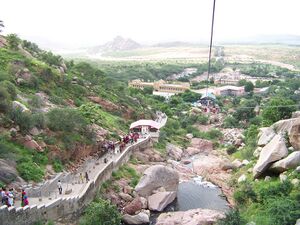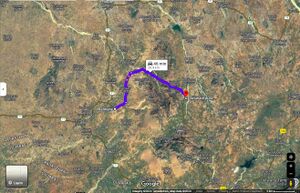Sundha Hill
| Author:Laxman Burdak, IFS (R) |


Sundha Hill is a site of Sundhamata Temple in Bhinmal tehsil of Jalore district situated in the mid-east of Malwara to Jaswantpura Road near Dantlawas village. Historically it is known for Sundha hill Inscription of Chachigadeva of V.S.1319 (A.D. 1262)
Variants
Sundha Mata temple
Sundha Mata temple is a nearly 900-year-old temple of Mother goddess Chamunda situated on a hilltop called Sundha.
Location
It is located at longitude 72.367°E and latitude 24.833°N, in Jalore District of Rajasthan, India. It is 64 km from Mount Abu and 20 km from the town of Bhinmal.[1] At 1,220 m (4,000 ft) height in the Aravalli ranges on Sundha mountain there is a temple of the goddess Chamunda Devi, worshipped as Sundha Mata by devotees. It is 105 km from district headquarters and 35 km from sub divisional Bhinmal.
Many devotees from Gujarat and Rajasthan and the rest of India visit it. The environment here is fresh and attractive. The waterfalls flows year-round at the mountain. Many communities of different castes established community centres for devotees, and there are very good facilities to stay at the hilltop at night and worship Chamunda.
Architecture
Sundha Mata temple is made up of white marble, the pillars reminiscent of the art of Abu's Dilwara temples pillars. An idol of goddess Chamunda stands under the huge stone. Here Chamunda's head is worshipped. It is said that the trunk of mother Chamunda are established in Korta and legs in Sundarla Pal (Jalore). In front of mother Chamunda a Bhur Bhuva Swaweshwar Shivling is established. In the main temple a duo idol of Shiva and Parvati, Ganesha's idol are considered very old and extinct.
History
In the temple premises there are three historically significant inscriptions that highlight the history of the region. The temple of Sundhamata was constructed by Dewal Pratiharas with the help of Imperial Chauhans of Jalore. The first inscription is from AD 1262, which describes victory of Chauhans and the downfall of Parmaras. The second inscription is from 1326, and the third one is from 1727.
The Sundha inscriptions are of particular importance in historical sense — like the Harishen inscription or Delhi's Mehrauli pillar inscription. Sundha inscriptions throw light on the history of India.
In ancient days worship in this temple was done by Nath Yogis. Emperor of the Sirohi state gave land of the "Sonani", "Dedol" and "Sundha ki dhani" villages to one of the Nath Yogi Rabad Nath Ji, who worshiped in Sundha Mata Temple at that time. After the death of one of the Nath yogi Ajay Nath ji, no one was there to do the worship so Ram Nath ji (Aayas of Mengalwa that time) was taken there to take the responsibility. The land of Mengalwa and Chitrodi villages were given to these Nath Yogis in ancient days by king of Jodhpur Maharaja Jaswant Singh. So Nath yogi of Mengalwa were called as "Aayas". After the death of Ram Nath ji, Badri Nath ji, pupil of Ram nath Ji became Aayas at Sundha Mata temple and took the responsibility of worship. He also looked after land of "Sonani", "Dedol" ,"Mengalwa" and "Chitrodi". As the time passed, no one was there to do all the management, so a trust (Sundha Mata Trust) was created to look after temple and manage tourism.
Shri Nath Ji Soni Sahib of Jaisalmer, the royal jewellers of the Jaisalmer State was also one of the prominent devotee of Sundhamata, another form of Chamunda Mata in Bhinmal, Jalore. Sundha Mata is the Kuldevi of the Shrimali Brahman Sonar of Lahecha Gotra i.e. Nathani Sonar.[2]
Wildlife sanctuary
There is a wildlife sanctuary nearby covering an area of 107 square kilometers. Nearest Khodeswar Mahadeva in Jawiya forest area also has wildlife and natural spots in the sanctuary. Sloth bear, Nilgai jungle cat, desert fox, striped hyena, hanuman langoor, vulture, owl, Indian porcupine, rock and jungle bush, quail, spotted dove, and 120 species of birds are found here.
Fairs
During Navaratri tourists from Gujarat and nearby areas come in large numbers. Regular buses are run by Gujarat roadways from Palanpur, Deesa and elsewhere during that time.
Amenities
Near the temple area a large community hall is established by the Trust for devotees to rest during the night and enjoy the scenery of the mountain.
Recently, a ropeway service has been started to climb Sundha Mountain, to make the journey easier for pilgrims, making it a memorable experience. Ropeway to the temple—first in Rajasthan—is ready, Rs 130 for both ways (Up & Down) and for up only RS. 106. For senior citizens RS. 65 (Age proof is required)
See also
References
Back to Jat Monuments

